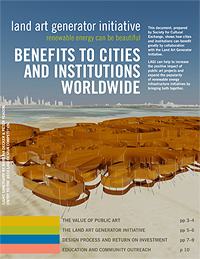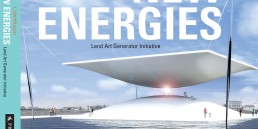“The final beauty of this initiative is that we now can explore the feasibility of implementing all of the leading submissions—creating a link between a future vision and today’s reality.” DR. SULTAN AL JABER, CEO OF MASDAR
Click the image to download the
LAGI Benefits to Cities
PDF Document
It shows how cities and institutions can benefit from the economic efficiencies of combining public art and renewable energy infrastructure.
When considering the capital costs of implementing utility-scale renewable energy artwork, the full spectrum of return on the investment should be considered.
This includes:
- City Beautification: all of the traditional benefits of public art.
- Education: artworks provide places for citizens to learn about sustainable systems and to see renewable energy in action. The Land Art Generator Initiative and Society for Cultural Exchange are available to provide workshops and educational programs in your city.
- Healthy Environment: CO2 emissions reduction results from the artwork construction.
- Healthy Communities: people coming together to support sustainable development.
- Economic Development: land art generators bring positive attention to the city.
- Innovation: interdisciplinary collaboration drives technological creativity.
- Electrical Generation: land art generators have the potential to power thousands of homes with clean and renewable energy.

The Land Art Generator Initiative addresses public art within the urban fabric of the sustainable city. The objective is to advance the successful implementation of sustainable urban design solutions by integrating art and interdisciplinary creative processes into the conception of renewable energy infrastructure. The project can be subdivided into four main areas of focus:
- LAGI design competition and associated events
- Educational materials
- Community outreach (lectures, workshops, and more)
- Construction of aesthetic renewable energy infrastructure for cities and institutions
A primary goal of LAGI is to design and construct a series of large-scale site-specific installations that combine art with utility-scale clean energy generation. The artworks utilize the latest in renewable energy science and innovate the application of new technologies.
Land Art Generator public artworks pay back both their carbon footprint and their installation cost over time, making them the perfect investment in our future.
The details of ROI from electricity generation will vary greatly depending on the nature of the design that is commissioned or selected from an open design competition process.
In addition to the sale of kilowatt-hours of electricity from these artworks, the return on investment should also consider the value that these artworks give to the community as economic development engines, centers of education and community awareness on issues of ecology, and their value as objects of city beautification.
When these additional factors are taken into consideration, these artworks could more accurately be seen as returning on their investment within the first year after their construction.
The capacity of public artwork (especially large-scale and high-profile works) to increase economic activity is well-documented. According to the NYC Economic Development Corporation, NYC Waterfalls by Olafur Eliasson, cost $15.5 million to install (privately funded) and brought an estimated $53 million in incremental spending from visitors who came to see the installation over the nearly four months that it was in operation. That’s an extra $483,000 per day to Manhattan businesses as a direct result of a public art installation.
Imagine a permanent work of art of a similar scale and with similar economic stimulus benefit.
And now imagine that this work of art educates hundreds of visitors every day about the technology that it employs, while contributing clean energy to the electrical grid (equivalent to the energy consumed by 1,000 homes). Now that is something to celebrate!


